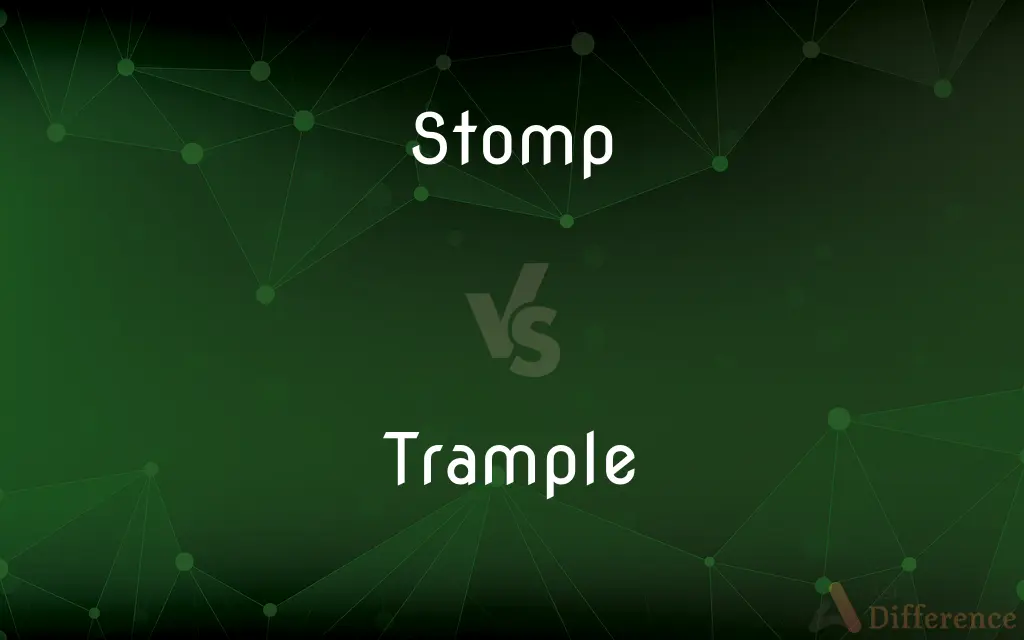Stomp vs. Trample — What's the Difference?
By Tayyaba Rehman & Urooj Arif — Updated on March 19, 2024
Stomping is forcefully striking the ground with a foot, while trampling involves stepping heavily and repeatedly on something, causing damage or injury.

Difference Between Stomp and Trample
Table of Contents
ADVERTISEMENT
Key Differences
Stomping refers to the act of forcefully bringing down one's foot or feet onto the ground or another surface, often to produce a sound or to express a strong emotion. It's a deliberate, single action that can be used as a form of communication, in dances, or to show frustration. On the other hand, trampling involves walking or stepping heavily and carelessly over something or someone, often resulting in damage or injury. Trampling can occur in a variety of contexts, including crowd movements or by animals, and implies repeated or continuous action.
The intention behind stomping and trampling can vary significantly. Stomping is often a conscious choice to make a statement, whether it's part of a dance routine or an expression of anger. It's about the impact of the foot hitting the ground or another surface. Trampling, however, generally indicates a lack of consideration for what is being stepped on, whether it's grass, flowers, or in more severe cases, another person or animal. The focus is on the movement and the potential harm caused by it.
The sound associated with stomping is usually louder and more singular, as it's meant to attract attention or convey a message. This can be seen in cultural dances or when someone is trying to signal their presence. Trampling, while it can also be noisy, often produces a series of sounds that indicate movement over an area or object, reflecting the repetitive nature of the action.
The context in which these actions occur also differs. Stomping is more likely to be seen in controlled environments like performances, protests, or individual expressions of emotion. Trampling is more common in situations of chaos, such as during a stampede, or in nature when animals move through vegetation or over obstacles without regard for their surroundings.
Despite their differences, both stomping and trampling can convey power and force. Stomping does so through a singular, impactful action, while trampling demonstrates force through repeated, often careless movement. Both actions, however, evoke strong visual and auditory effects, underlining their respective intents and outcomes.
ADVERTISEMENT
Comparison Chart
Definition
Forcefully striking the ground with foot
Stepping heavily and repeatedly on something
Intention
Often to make a statement or noise
Usually careless, causing harm or damage
Sound
Loud, singular impact
Series of sounds from movement
Context
Performances, expressions of emotion
Chaos, movement through areas
Implication
Communication, expression
Damage, lack of consideration
Compare with Definitions
Stomp
Used to express frustration or to attract attention.
She stomped her feet in protest.
Trample
Often results from a lack of consideration or awareness.
In their haste, they trampled over the flowerbeds.
Stomp
To signal or make a noise by stomping.
The children stomped around the room, pretending to be monsters.
Trample
Indicates movement without regard for the surroundings.
The fleeing animals trampled through the garden.
Stomp
Indicates a deliberate action.
He stomped on the brake pedal to stop the car suddenly.
Trample
Associated with injury or destruction.
He was trampled in the stampede and sustained injuries.
Stomp
A vigorous, forceful stamp of one's foot on the ground.
He stomped his foot to emphasize his anger.
Trample
To step heavily and repeatedly on something, causing damage.
The crowd trampled the grass into mud.
Stomp
Part of dance moves in certain cultural dances.
The dance routine included a series of loud stomps.
Trample
Reflects chaos or lack of control.
The soldiers trampled through the village, leaving destruction in their wake.
Stomp
Tread heavily and noisily, typically in order to show anger
Martin stomped off to the spare room
Trample
To beat down with the feet so as to crush, bruise, or destroy; tramp on.
Stomp
(in jazz or popular music) a tune or song with a fast tempo and a heavy beat.
Trample
To treat harshly or ruthlessly
Would trample anyone who got in their way.
Stomp
To bring down (the foot) forcibly.
Trample
To tread heavily or destructively
Trampling on the flowers.
Stomp
To bring the foot down onto (an object or surface) forcibly.
Trample
To inflict injury as if by treading heavily
"trampling on the feelings of those about you" (Thornton Wilder).
Stomp
To tread or trample heavily or violently on
Stomping the ground to even it out.
Trample
The action or sound of trampling.
Stomp
To cause to be dislodged by stomping the feet
Stomped the mud off her boots.
Trample
(transitive) To crush something by walking on it.
To trample grass or flowers
Stomp
To bring the foot down onto an object or surface forcibly
Stomped on the gas pedal.
Trample
(by extension) To treat someone harshly.
Stomp
To tread or trample heavily or violently
I stomped on the sidewalk to get the dirt off my shoes.
Trample
(intransitive) To walk heavily and destructively.
Stomp
To walk with forcible, heavy steps
He got mad and stomped out of the room.
Trample
(by extension) To cause emotional injury as if by trampling.
Stomp
A dance involving a rhythmical, heavy step.
Trample
A heavy stepping.
Stomp
The jazz music for this dance.
Trample
The sound of heavy footsteps.
Stomp
(ambitransitive) To trample heavily.
Trample
To tread under foot; to tread down; to prostrate by treading; as, to trample grass or flowers.
Neither cast ye your pearls before swine, lest they trample them under their feet.
Stomp
To severely beat someone physically or figuratively.
Trample
Fig.: To treat with contempt and insult.
Stomp
(transitive) To crush grapes with one's feet to make wine
Trample
To tread with force and rapidity; to stamp.
Stomp
A deliberate heavy footfall; a stamp.
She obliterated the cockroach with one stomp.
Trample
To tread in contempt; - with on or upon.
Diogenes trampled on Plato's pride with greater of his own.
Stomp
A dance having a heavy, rhythmic step.
Trample
The act of treading under foot; also, the sound produced by trampling.
The huddling trample of a drove of sheep.
Stomp
The jazz music for this dance.
Trample
The sound of heavy treading or stomping;
He heard the trample of many feet
Stomp
To stamp with the foot.
Trample
Tread or stomp heavily or roughly;
The soldiers trampled across the fields
Stomp
A dance involving a rhythmical stamping step
Trample
Injure by trampling or as if by trampling;
The passerby was trampled by an elephant
Stomp
Walk heavily;
The men stomped through the snow in their heavy boots
Trample
Walk on and flatten;
Tramp down the grass
Trample the flowers
Common Curiosities
What does trample mean?
To trample means to step heavily and repeatedly on someone or something, often causing damage or harm.
What does it mean to stomp?
Stomping is the act of forcefully bringing down one's foot onto the ground or another surface, often as a form of expression or communication.
Can humans trample things?
Yes, humans can trample objects, vegetation, and even other people, especially in crowded or chaotic situations.
Why do animals trample?
Animals might trample as part of their natural behavior when moving through their habitat or in response to threats, often without awareness of the damage they cause.
How can trampling be prevented in crowds?
Trampling in crowds can be prevented with adequate safety measures, crowd control strategies, and clear exit paths to manage movement and avoid panic.
Is stomping always intentional?
Stomping is usually an intentional action, done to convey a message, emotion, or signal.
Can stomping be part of a cultural performance?
Yes, stomping is often a feature in cultural dances and performances, used to produce rhythm and show vitality.
What is the difference between stomping and trampling?
The main difference lies in their intent and outcome: stomping is a deliberate action often used for expression or communication, while trampling involves careless, heavy stepping that results in damage or harm.
What environments are most at risk of trampling?
Natural environments like parks, wildlife reserves, and gardens are most at risk of trampling, especially in areas with high foot traffic or unregulated access.
Is stomping used in any sports?
Stomping is not typically a part of sports; however, it can be seen in sports fans' behaviors as a way to cheer or express excitement during games.
What is the purpose of stomping?
Stomping can serve various purposes, including making a statement, expressing emotions, attracting attention, or being part of a dance.
How can one reduce the impact of trampling?
Reducing the impact of trampling can involve sticking to designated paths, using boardwalks or other protective measures in vulnerable areas, and educating the public about the consequences of off-path travel.
Are there any psychological effects of stomping or trampling in humans?
Stomping, when used as an expression of emotion, can release tension or anger, whereas being trampled or witnessing trampling can lead to psychological trauma or stress.
Can trampling affect wildlife?
Yes, trampling can significantly impact wildlife, destroying habitats, and disturbing animal populations, especially in sensitive ecosystems.
Share Your Discovery

Previous Comparison
Light vs. Pale
Next Comparison
Solvent vs. SoluteAuthor Spotlight
Written by
Tayyaba RehmanTayyaba Rehman is a distinguished writer, currently serving as a primary contributor to askdifference.com. As a researcher in semantics and etymology, Tayyaba's passion for the complexity of languages and their distinctions has found a perfect home on the platform. Tayyaba delves into the intricacies of language, distinguishing between commonly confused words and phrases, thereby providing clarity for readers worldwide.
Co-written by
Urooj ArifUrooj is a skilled content writer at Ask Difference, known for her exceptional ability to simplify complex topics into engaging and informative content. With a passion for research and a flair for clear, concise writing, she consistently delivers articles that resonate with our diverse audience.















































